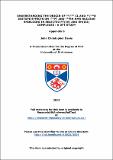Files in this item
Understanding the origin of ³⁵/³⁷ Cl and ¹⁶/¹⁸O isotope effects on ¹⁹⁵Pt and ¹⁰³Rh NMR nuclear shielding in selected Pt(lV) and Rh(lll) Complexes : a DFT study
Item metadata
| dc.contributor.advisor | Bühl, Michael | |
| dc.contributor.advisor | Koch, Klaus R. | |
| dc.contributor.author | Davis, John C. | |
| dc.coverage.spatial | xix, 126 | en_US |
| dc.date.accessioned | 2013-06-27T09:32:13Z | |
| dc.date.available | 2013-06-27T09:32:13Z | |
| dc.date.issued | 2013 | |
| dc.identifier | uk.bl.ethos.574854 | |
| dc.identifier.uri | https://hdl.handle.net/10023/3824 | |
| dc.description.abstract | Distinctive fine-structure due to ³⁵Cl/³⁷Cl isotopologue and isotopomer effects is resolved at high magnetic fields for ¹⁹⁵Pt and ¹⁰³Rh NMR signals, resulting in a unique NMR “finger-print”, with which it is possible to uniquely identify all chlorido containing Pt(IV) and Rh(III) complexes. In this study, these isotope shifts are computed from first principles in order to provide a solid theoretical framework for the empirical observations. Use is made of DFT to calculate the ³⁵/³⁷Cl and ¹⁶/¹⁸O induced isotope shifts in the ¹⁹⁵Pt NMR spectra of [Pt³⁵Cl₆]²⁻ and [Pt³⁷Cl₆]²⁻, for the [Pt³⁵Cl n ³⁷Cl₅₋ n(H₂O)]⁻ (n=0-5), cis-Pt³⁵Cln³⁷Cl₍₄₋n₎(H₂O)₂ (n=0-4), and fac-[Pt³⁵Cl n³⁷Cl₍₃₋ n₎(H₂O)₃]⁺ (n=0-3) series. The computational protocol is extended to calculate the ³⁵/³⁷Cl and ¹⁶/¹⁸O induced isotope shifts in [Pt³⁵Cl n³⁷Cl₍₅₋ n₎(OH)]²⁻ (n=0-5), cis- [Pt³⁵Cln³⁷Cl₍₄₋ n₎(OH)₂]²⁻ (n=0-4), fac-[Pt³⁵Cln³⁷Cl₍₃₋ n₎(OH)₃] ²⁻ (n=0-3), cis- [Pt³⁵Cl n³⁷Cl₂₋n(OH)₄]²⁻ (n=0-2) and [Pt³⁵Cl n³⁷Cl₍₁₋ n₎(OH)₅]²⁻ (n=0-1). For Rh(III), the ³⁵Cl/³⁷Cl isotope shifts in the ¹⁰³Rh NMR spectra of [Rh³⁵Cl n³⁷Cl₅₋ n(H₂O)] ²⁻ (n=0-5), cis-[Rh³⁵Cl n³⁷Cl₍₄₋ n₎(H₂O)₂]⁻ (n=0-4), and fac-Rh³⁵Cl n³⁷Cl₍₃₋ n₎(H₂O)₃ (n=0-3) were calculated. The ¹⁹⁵Pt and ¹⁰³Rh NMR chemical shifts computed for these species reproduce the order of magnitude of the observed effect reasonably well, up to ca. 1 ppm. In most cases, general trends are also captured qualitatively, thus providing the first theoretical basis for the origin of subtle isotope shifts in ¹⁹⁵Pt NMR spectra. Neither simple polarizable continuum models nor small, microsolvated complexes lead to improved isotope shifts for the series investigated, however, valuable insight into the degree of solvent interaction was gained. Using the polarized continuum model to calculate shielding/bond-length derivatives together with gas-phase zero-point corrections to estimate shieldings, it was shown that the contraction of the coordination sphere in the hydroxide complexes cause the Pt-Cl bonds to become magnetically equivalent, justifying why their isotopomers aren’t resolved. In this study, theoretical modelling of structural effects on NMR parameters extends to the smallest scale, distance changes of a few femtometers upon isotopic substitution. | en_US |
| dc.language.iso | en | en_US |
| dc.publisher | University of St Andrews | |
| dc.subject | NMR | en_US |
| dc.subject | Platinum | en_US |
| dc.subject | DFT | en_US |
| dc.subject | Rhodium | en_US |
| dc.subject.lcc | QD96.N8D2 | |
| dc.subject.lcsh | Nuclear magnetic resonance spectroscopy | en_US |
| dc.subject.lcsh | Platinum compounds--Spectra | en_US |
| dc.subject.lcsh | Rhodium compounds--Spectra | en_US |
| dc.subject.lcsh | Chlorine--Isotopes | en_US |
| dc.subject.lcsh | Oxygen--Isotopes | en_US |
| dc.subject.lcsh | Density functionals | en_US |
| dc.title | Understanding the origin of ³⁵/³⁷ Cl and ¹⁶/¹⁸O isotope effects on ¹⁹⁵Pt and ¹⁰³Rh NMR nuclear shielding in selected Pt(lV) and Rh(lll) Complexes : a DFT study | en_US |
| dc.type | Thesis | en_US |
| dc.contributor.sponsor | Stellenbosch University | en_US |
| dc.contributor.sponsor | Anglo Platinum Ltd. | en_US |
| dc.type.qualificationlevel | Doctoral | en_US |
| dc.type.qualificationname | PhD Doctor of Philosophy | en_US |
| dc.publisher.institution | The University of St Andrews | en_US |
| dc.publisher.department | Stellenbosch University | en_US |
This item appears in the following Collection(s)
Items in the St Andrews Research Repository are protected by copyright, with all rights reserved, unless otherwise indicated.


